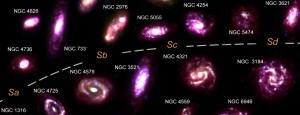
The images of many different kinds of galaxies were created using observations from the Spitzer SINGS survey and the Herschel KINGFISH survey. From http://www.astro.umd.edu/~rhc/bigbang/boxed/research_blog.html.
For today’s astronomy seminar, we had Rodrigo Herrera from University of Maryland Astronomy. Rodrigo spoke about using far infrared observations from the Herschel instrument to study star formation in nearby galaxies.
Rodrigo talked about using emission at 158 microns, created by ionized carbon atoms (CII), to probe the rates of star formation. The hottest and youngest stars in a stellar nursery, O and B stars, are thought to heat dust grains, charging them slightly. The resulting excess electrons then escape into the gas surrounding the stellar nursery, heating it. Some of that gas is ionized carbon, which cools by emitting photons at a very specific wavelength, 158 microns.
By observing how much 158-micron emission is coming from a galaxy (and applying some important corrections to account for the variation in the physical environments in each star-forming region), Rodrigo showed that astronomers could pretty accurately estimate the rate at which stars are forming throughout that galaxy.
Understanding the star formation rate is important for may aspects of astronomy, but in particular, the star formation rate is a key parameter for the Drake equation, which estimates the number of intelligent and communicating civilizations in the universe. Such civilizations probably grow up orbiting a star similar to the Sun, so knowing how often such stars form goes a long way to telling us how many extraterrestrial civilizations might be out there.